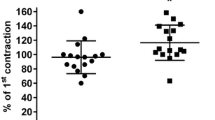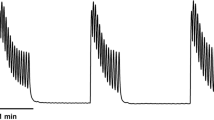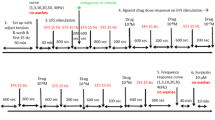Abstract
Openers of KATP channels are known to inhibit KCl-, carbachol- and also electrically induced contractions in detrusor muscle strips from various species. Contractions of isolated strips of urinary bladder are usually of higher amplitude when the urothelium has been removed. This has been explained by the release of an urothelium-derived relaxing factor. In this study we examined whether intact urothelium may modulate the effect of the selective KATP channel opener rilmakalim. Contractile responses to 85 mM KCl and 10 μM carbachol were measured in detrusor strips from mouse, pig and man. In the presence of an intact urothelium, contractions were significantly reduced in strips from all three species investigated. In preparations with urothelium rilmakalim reduced KCl contractions with similar potency and efficacy [−logIC50 (M) 4.6 to 5.1; Effmax reduction to 14-30% of control]. However, in urothelium-denuded strips rilmakalim was more potent in pig (−logIC50 5.5) than in mouse and man (−logIC50 4.7 and 4.4, respectively). The order of potency for rilmakalim to suppress carbachol-induced contractions was pig (—logIC50 6.7) > man (5.8) > mouse (4.7); contractions were significantly more reduced in pig (Effmax reduction to 11±2%, n=10) and in mouse (21±2%, n=8) than in human detrusor (55±5%, n=5). The presence of urothelium did not affect the concentration–response curves for rilmakalim, with the exception of KCl-induced contractions in pig. Only the rilmakalim-induced relaxation of carbachol-mediated contractions in pig were prevented by the KATP channel blocker glibenclamide. We conclude that with this one exception, the responses to rilmakalim in detrusor contractions were not mediated by KATP channel opening.







Similar content being viewed by others
References
Andersson KE (1992) Clinical pharmacology of potassium channel openers. Pharmacol Toxicol 70:244–254
Andersson KE, Yoshida M (2003) Antimuscarinics and the overactive detrusor—which is the main mechanism of action? Eur Urol 43:1–5
Andersson KE, Arner A (2004) Urinary bladder contraction and relaxation: physiology and pathophysiology. Physiol Rev 84:935–986
Andersson KE, Chapple C, Wein A (2001) The basis for drug treatment of the overactive bladder. World J Urol 19: 294–298
Andersson KE, Appell R, Awad S, Chapple C, Druttz H, Finkebeiner A, Fourcroy J, Haab F, Wein A (2002) Pharmacological treatment of urinary incontinence. In: Abrams P, Cardozo L, Khoury S, Wein A (eds) Incontinence: 2nd International Consultation on Incontinence. Plybridge Distributors Ltd, UK, pp 481–511
Balana B, Dobrev D, Wettwer E, Christ T, Knaut M, Ravens U (2003) Decreased ATP-sensitive K+ current density during chronic human atrial fibrillation. J Mol Cell Cardiol 35:1399–1405
Bonev AD, Nelson MT (1993) ATP-sensitive potassium channels in smooth muscle cells from guinea pig urinary bladder. Am J Physiol 264:C1190–C1200
Carroll WA, Agrios KA, Altenbach RJ, Buckner SA, Chen Y, Coghlan MJ, Daza AV, Drizin I, Gopalakrishnan M, Henry RF, Kort ME, Kym PR, Milicic I, Smith JC, Tang R, Turner SC, Whiteaker KL, Zhang H, Sullivan JP (2000) Synthesis and structure-activity relationships of a novel series of tricyclic dihydropyridine-based KATP openers that potently inhibit bladder contractions in vitro. J Med Chem 47:3180–3192
Carroll WA, Altenbach RJ, Bai H, Brioni JD, Brune ME, Buckner SA, Cassidy C, Chen Y, Coghlan MJ, Daza AV, Drizin I, Fey TA, Fitzgerald M, Gopalakrishnan M, Gregg RJ, Henry RF, Holladay MW, King LL, Kort ME, Kym PR, Milicic I, Tang R, Turner SC, Whiteaker KL, Yi L, Zhang H, Sullivan JP (2004) Synthesis and structure-activity relationships of a novel series of 2,3,5,6,7,9-hexahydrothieno[3,2-b]quinolin-8(4H)-one 1,1-dioxide K(ATP) channel openers: discovery of (-)-(9S)-9-(3-bromo-4-fluorophenyl)-2,3,5,6,7,9- hexahydrothieno[3,2-b]quinolin-8(4H)-one 1,1-dioxide (A-278637), a potent K(ATP) opener that selectively inhibits spontaneous bladder contractions. J Med Chem 47:3163–3179
Chaiyaprasithi B, Mang CF, Kilbinger H, Hohenfellner M (2003) Inhibition of human detrusor contraction by a urothelium derived factor. J Urol 170:1897–1900
Chen MX, Gorman SA, Benson B, Singh K, Hieble JP, Michel MC, Tate SN, Trezise DJ (2004) Small and intermediate conductance Ca2+-activated K+ channels confer distinctive patterns of distribution in human tissues and differential cellular localisation in the colon and corpus cavernosum. Naunyn Schmiedebergs Arch Pharmacol 369:602–615
de Moura RS, de Mello RF, D'Aguinaga S (1993) Inhibitory effect of cromakalim in human detrusor muscle is mediated by glibenclamide-sensitive potassium channels. J Urol 149:1174–1147
Dveksler G, Gimeno MF, Gimeno AL (1987) Cholinergic and non-cholinergic components of the inotropism evoked by electric field stimulation in the isolated rat urinary bladder. Influence of some eicosanoids. Pharmacol Res Commun 19 :295–305
Foster CD, Fuji K, Kingdon J, Brading AF (1989a) The effect of cromakalim on the smooth muscle of the guinea-pig urinary bladder. Br J Pharmacol 97:281–291
Foster CD, Speakman, MJ, Fuji I, Brading AF (1989b) The effects of cromakalim on the detrusor muscle of human and pig urinary bladder. Br J Urol 63:284–294
Fuji K, Foster CD, Brading AF, Parekh AB (1990) Potassium channel blockers and the effects of cromakalim on the smooth muscle of the guinea-pig bladder. Br J Pharmacol 99:779–785
Gonoi T, Seino S (2000) Structure and function of ATP-sensitive K+ channels. In: Endo M, Kurachi Y and Mishina M (eds) Pharmacology of ionic channel function: activators and inhibitors. Springer, Berlin Heidelberg New York, pp 271–295
Hawthorn MH, Chapple CR, Cock M, Chess-Williams R (2000) Urothelium-derived inhibitory factors influences on detrusor muscle contractility in vitro. Br J Pharmacol 129:416–419
Herrera GM, Heppner TJ, Nelson MT (2001) Voltage dependence of the coupling of Ca2+ sparks to BK(Ca) channels in urinary bladder smooth muscle. Am J Physiol Cell Physiol 280:C480–C490
Howe BB, Halterman TJ, Yochim CL, Do ML, Pettinger SJ, Stow RB, Ohnmacht CJ, Russell K, Empfield JR, Trainor DA (1995) ZENECA ZD6169: a novel KATP channel opener with in vivo selectivity for urinary bladder. J Pharmacol Exp Ther 274:884–890
Klöckner U, Isenberg G (1985) Action potentials and net membrane currents of isolated smooth muscle cells (urinary bladder of the guinea-pig). Pflügers Arch 405:329–339
Levin RM, Wein AJ, Krasnopolsky L, Atta MA, Ghoniem GM (1995) Effect of mucosal removal on the response of the feline bladder to pharmacological stimulation. J Urol 153:1291–1294
Maggi CA, Santicioli P, Parlani M, Astolfi M, Patacchini R, Meli A (1987) The presence of mucosa reduces the contractile response of the guinea-pig urinary bladder to substance P. J Pharm Pharmacol 39:653–655
Malysz J, Buckner SA, Daza AV, Milicic I, Perez-Medrano A, Gopalakrishnan M (2004) Functional characterization of large conductance calcium-activated K+ channel openers in bladder and vascular smooth muscle. Naunyn Schmiedebergs Arch Pharmacol 369:481–489
Martin SW, Radley SC, Chess-Williams R, Korstantje C, Chapple CR (1997) Relaxant effects of potassium-channel openers on normal and hyper-reflexic detrusor muscle. Br J Urol 80:405–413
Meredith AL, Thorneloe KS, Werner ME, Nelson MT, Aldrich RW (2004) Overactive bladder and incontinence in the absence of the BK large conductance Ca2+-activated K+ channel. J Biol Chem 35:36746–36752
Nakamura T, Kimura J, Yamaguchi O (2002) Muscarinic M2 receptors inhibit Ca2+-activated K+ channels in rat bladder smooth muscle. Int J Urol 161:649–653
Nurse DE, Restorick JM, Mundy AR (1991) The effect of cromakalim on the normal and hyper-reflexic human detrusor muscle. Br J Urol 68:27–31
Ouslander JG (2004) Management of overactive bladder. N Engl J Med 350:786–799
Pinna C, Caratozzolo O, Puglisi L (1992) A possible role for urinary bladder epithelium in bradykinin-induced contraction in diabetic rats. Eur J Pharmacol 214:143–148
Russ U, Lange U, Löffler-Walz C, Hambock A, Quast U (2003) Binding and effect of KATP channel openers in the absence of Mg2+. Br J Pharmacol 139:368–380
Saban R, Keith IM, Nielsen KT, Christensen MM, Rhodes PR, Bruskewitz RC (1992) In vitro effects of bladder mucosa and an enkephalinase inhibitor on tachykinin induced contractility in the dog bladder. J Urol 147:750–755
Schneider T, Fetscher C, Krege S, Michel MC (2004a) Signal transduction underlying carbachol-induced contraction of human urinary bladder. J Pharmacol Exp Ther 309:1148–1153
Schneider T, Hein P, Michel MC (2004b) Signal transduction underlying carbachol-induced contraction of rat urinary bladder. I. phospholipases and Ca2+ sources. J Pharmacol Exp Ther 308:47–53
Sheldon JH, Norton, NW, Argentieri TM (1997) Inhibition of guinea pig detrusor contraction by NS-1619 is associated with activation of BKCa and inhibition of calcium currents. J Pharmacol Exp Ther 283:1193–1200
Templeman L, Chapple CR, Chess-Williams R (2002) Urothelium derived inhibitory factor and cross-talk among receptors in the triangle of the bladder of the pig. J Urol 167:742–745
Trivedi S, Stetz S, Levin R, Li J, Kau S (1994) Effect of cromakalim and pinacidil on 86Rb efflux from guinea pig urinary bladder smooth muscle. Pharmacology 49:159–166
Wammack R, Jahnel U, Nawrath H, Hohenfellner R (1994) Mechanical and electrophysiological effects of cromakalim on the human urinary bladder. Eur Urol 26:176–181
Wegener JW, Schulla V, Lee TS, Koller A, Feil S, Feil R, Kleppisch T, Klugbauer N, Moosmang S, Welling A, Hofmann F (2004) An essential role of Cav1.2 L-type calcium channel for urinary bladder function. FASEB J 18:1159–1161
Wüst M, Averbeck B, Reif S, Bräter M, Ravens U (2002) Different responses to drugs against overactive bladder in detrusor muscle of pig, guinea pig and mouse. Eur J Pharmacol 454:59–69
Wuest M, Hecht J, Christ T, Braeter M, Schoeberl C, Hakenberg OW, Wirth MP, Ravens U (2005) Pharmacodynamics of propiverine and three of its metabolites on detrusor contraction. Br J Pharmacol (published online May 9)
Zografos P, Li JH, Kau ST (1992) Comparison of the in vitro effects of K+ channel modulators on detrusor and portal vein strips from guinea pigs. Pharmacology 45:216–230
Acknowledgements
The authors thank Prof. Dr. U. Quast, University of Tübingen, Germany for his stimulating discussion and helpful comments. We gratefully acknowledge the excellent technical assistance of Sabine Kirsch. M.W. and S.K. were financially supported by APOGEPHA Arzneimittel GmbH Dresden, Germany.
Author information
Authors and Affiliations
Corresponding author
Rights and permissions
About this article
Cite this article
Wuest, M., Kaden, S., Hakenberg, O.W. et al. Effect of rilmakalim on detrusor contraction in the presence and absence of urothelium. Naunyn Schmied Arch Pharmacol 372, 203–212 (2005). https://doi.org/10.1007/s00210-005-0015-4
Received:
Accepted:
Published:
Issue Date:
DOI: https://doi.org/10.1007/s00210-005-0015-4




